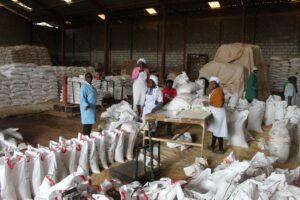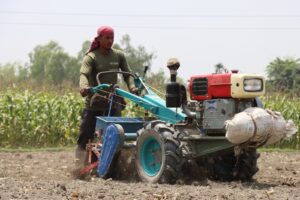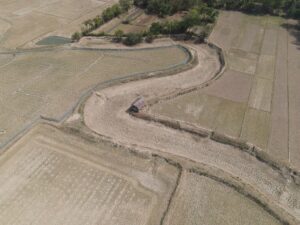Uganda—widely known as “the pearl of Africa” for its exquisite natural beauty, diverse flora and fauna, and rich mosaic of cultures— is attracting attention today as a potential rice basket for eastern Africa.
Over the last few years, Uganda has been experiencing a remarkable rice boom supported by good farming practices, premium market prices, and favorable policies that have stimulated large private investment in the rice sector.
The growth of Uganda’s rice production has contributed to greater food security and a reduction in rice imports. For instance, according to the Ugandan government, rice imports dropped between 2005 and 2008, which helped save the country about US$30 million in foreign exchange earnings.
The area sown to rice nearly doubled from about 80,000 hectares in 2002 to about 150,000 hectares in 2011. Similarly, paddy production jumped from about 120,000 tons in 2002 to more than 220,000 tons in 2011.
“The rice industry in the country has rapidly moved from improved seed to production to processing and to the markets over the last few years,” said Robert Anyang, program officer of Public-Private Partnership and Market Access at Sasakawa Global 2000 (SG2000).
This is a feat that several rice-producing countries in sub-Saharan Africa would like to achieve. Yet, 10 years ago, Uganda was barely known as a rice-producing country in the region. So, what triggered the rice transformation?
NERICA fills the void
In 2000 and 2001, when the price of maize plunged in the region, Uganda’s government and farmers were desperate for an alternative crop that could provide food security and income.
Through the timely assistance provided by SG2000 and the National Agricultural Research Organization (NARO), short-duration NERICA varieties developed by the Africa Rice Center(AfricaRice), including NERICA 1, 4, and 10, were identified as a suitable replacement for maize. NERICA 4 was released in 2002 and followed by NERICA 1 and 10.
“In a short time, NERICA 4 became so popular that, by 2008, it occupied almost 70% of the upland area under production,” said Dr. Jimmy Lamo, a rice breeder at NARO.
The turning point
Gilbert Bukenya, the then vice president of Uganda, identified upland rice as a major strategic intervention for food security and poverty reduction. Because of Dr. Bukenya’s advocacy, President Yoweri Museveni launched the Upland Rice Project in 2004. This is widely acknowledged as the turning point for the growth of Uganda’s rice sector.
The campaign encouraged several non-government organizations (NGOs) and development partners to join forces with the Ugandan government. These were the Japan International Cooperation Agency, the United Nations Development Programme, the Food and Agriculture Organization of the United Nations, Oxfam, and the United States Agency for International Development, in addition to SG2000.
The government and these partners made major efforts to promote rice and strengthen the capacity of rice farmers, millers, traders, and extension workers.
The rice scheme also motivated private-sector players such as NASECO Seed Company, Grow More Seeds, Pearl Seeds, Victoria Seeds, and FICA Seeds.
“The Upland Rice Project is a success story of public-private partnership, with each partner playing a role from research to final product and commercialization,” said Nicolai Rodeyns, managing director of NASECO Seed Company. NASECO was instrumental in the production and dissemination of certified seed of NERICA 4 under the trade name Suparica 2.
The breakthrough
However, the real breakthrough for Uganda’s rice sector occurred in the mid-2000s when the Ugandan government lobbied successfully for the East African Community to impose a 75% tariff on rice imports (35% for Kenya), according to Mr. Anyang.
“As the Ugandan government didn’t have the money to support subsidies, this was a good way to promote its fledgling rice industry and protect farmers from the influx of cheap imported rice,” he commented.
The shift in government policy further stimulated rice production in the country and motivated the private sector to invest heavily in the sector. The focus gradually shifted from increasing rice production to improving postharvest handling, value addition, and marketing.
According to Mr. Venugopal Pookat, director of Tilda Uganda Ltd., one of the leading rice-producing companies in the country, locally produced rice can replace imported rice, only if it can be price-competitive, branded with consistent quality, and readily available on the market. Tilda Uganda Ltd. produces different types of rice to fill different market niches.
Similarly, small entrepreneurs have seized the opportunity to add value by developing niche products such as parboiled rice, which is not commonly available in Uganda.
Market integration
Public- and private-sector partners in Uganda’s rice sector are aware that agricultural intensification goes hand in hand with agricultural sector development and market integration at all levels.
“The activities involved in rice value addition have potential to create wealth for all in the value chain, including farmers, transporters, middlemen, millers, traders, and the economy,” explained Mr. Philip Idro, former Ugandan ambassador to China and current director of Upland Rice Millers Ltd. (URM).
The URM rice factory in Jinja, in eastern Uganda, is helping rice farmers to become part of agribusiness networks through which they can sell surplus crops and invest in their farms. For example, rice farmers who bring their paddy to the factory for milling find a ready market as they meet with rice traders at the same place.
“As long as farmers have a market, they always respond positively to that market so production is no longer an issue,” explained Ms. Joan Rutaroh, program director of the Uganda Development Trust, a local NGO that provides technical assistance and arranges agribusiness loans for small and medium rice enterprises.
Joyce Lalam Otema, a rice farmer from Gulu, agreed. “With rice, you can’t go wrong,” she observed. “Each time you get a good yield, all the rice is sold in 2–3 months. You can either sell it locally or go to the nearest mill.”
In addition to a large mill owned by Tilda Uganda Ltd., the country has 15 medium-sized mills and about 850 small mills with polishers and whiteners.
Lowland rice production
The boom in Uganda’s rice production is also partly due to the resurgence of the Kibimba Rice Scheme. It currently produces about 20,000 tons of rice per year, which is 20% of the total rice produced in the country.
Although rice schemes are huge, they are still small considering Uganda has about 500,000 hectares of land suitable for seasonal lowland rice production. According to the National Rice Development Strategy, Uganda is expected to produce up to 335,000 tons of rice in 2013 and 500,000 tons in 2018. New lowland rice varieties are expected to be released soon by NARO.
“With everything in place, including the right policy and all the actors, the support of rice research partners through the new CGIAR Global Rice Science Partnership, and with the private sector, we can achieve this goal in the next 5 years,” said Mr. Anyang.
______________________
Ms. Mohapatra is the head of Marketing and Communications at AfricaRice.









i would like to get in touch regarding a piece of equipment that i saw in your articles that helps farmers to prepare land for paddy rice.
kindly get in touch with me . thanks